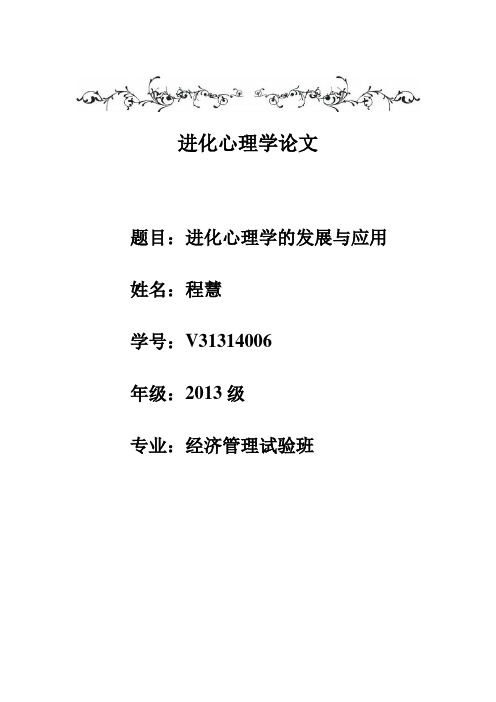进化论的发展史【英文】
- 格式:ppt
- 大小:888.50 KB
- 文档页数:32


英文发展历程The English language is one of the most widely spoken languages in the world today, used by more than 1.5 billion people globally. But how did it develop into the language as we know it today? In this article, we’ll take a brief look at the history of the English language and its evolution over time.The Beginnings of EnglishThe origins of English as a language can be traced back to the fifth century when Germanic tribes, including the Angles, Saxons, and Jutes, invaded what is now England. These tribes spoke different dialects of what is known as Old Germanic, which became the basis for Old English. Old English was a complex language that had many inflections and three genders.Middle EnglishAround the twelfth century, the English language began to change as a result of the Norman Invasion of England in 1066. The Normans spoke Old French, which influenced and gradually replaced the Old English language. This new language was known as Middle English, which had a simpler grammarstructure and fewer inflections. Middle English had asignificant impact on shaping the English language to what it is today.Early Modern EnglishThe sixteenth century marks a significant period in the development of the English language. The Great Vowel Shift, which began in the early fifteenth century, completely changed the way vowels were pronounced in English. This period also saw the introduction of many loanwords from other languages, such as Latin, French, and Greek. The Renaissance, which saw a revival of interest in classical literature, also influenced the development of the English language.Late Modern EnglishIn the eighteenth century, the English language began to standardize, and the first dictionaries and grammars of the English language were published. This period saw a rise in British colonialism, which led to the spread of the English language to other parts of the world. In the nineteenth century, the Industrial Revolution and the growth of the middle class contributed to the emergence of new words and phrases in the English language.Contemporary EnglishThe development of technology, globalization, and the internet has significantly influenced the English language in recent years. English has become the language ofinternational business, science, and communication, and it has evolved to incorporate new words and phrases. The use of text messaging and social media has also led to the development of new slang and abbreviations in the English language.In conclusion, English has evolved over time by incorporating influences from other languages, adapting to changes in society and technology, and evolving to meet the needs of its users. The English language will continue to evolve as the world becomes more connected, and new technologies emerge.。


媒介进化论_从保罗_莱⽂森说起2009年第3期(总第55期)推进创新理论探索创新实践DONGNANCHUANBO摘要:保罗·莱⽂森是北美媒介⽣态学研究的第三代代表⼈物,他的“补偿性媒介”理论⼴为⼈知。
本⽂具体介绍了莱⽂森关于媒介进化研究的著名“三理论”,并从技术和社会⽂化两个维度概述了现阶段媒介进化的相关研究,试图阐述数字时代媒介进化研究趋势。
关键词:媒介进化保罗·莱⽂森技术社会⽂化媒介总是处于⼀个不断进化的过程,当媒介依赖的内外环境发⽣变化的时候,媒介也能够通过⾃我调节和适应机制,在传播理念、传播⽅式、传播形态等各个⽅⾯发⽣改变。
研究媒介进化不但有利于了解⽬前媒介⽣态的基本情况,同时也能掌握媒介进化规律,提早预测媒介发展趋势,充分保障⼈类社会的信息需求和信息传播的平衡、公正等。
⼀、媒介进化的概念辨析在新旧媒体之间,不断经历着软约束与硬约束、渐变与突变的交替过程,来⾃于媒介发展内外环境的各类约束条件,事实上构成了媒介发展的选择压⼒,媒介或者被迫或者主动进⼊⾃然选择过程①。
可见,将⽣物学中的进化观点引⼊媒介研究显得较为合理。
媒介进化论的英⽂是mediaevolutiontheory ,在中⽂中,evolution 可翻译为“进化”、“演化”。
“进化”是指原⽣物在原来的基础上的加强变化后的结果,并且是保留原有的东西;“演化”是丢弃原来的东西,变成现在的东西,并不具备原有的基础。
⽽媒介是⼀个不断变化发展的事物,任何⼀个媒介都曾经是⼀个新的媒介,并且必将成为⼀个旧的媒介。
“每种媒介都有⾃⾝的优势与劣势,它也会将这些强加在所携带的讯息上。
新媒介通常并不会消灭旧媒介,它们只是将旧媒介推到它们具有相对优势的领域。
②”尤其是信息时代的到来、现代科技的快速发展、互联⽹技术的涌现使得媒介不断探寻新的发展形态,谋求获得⼀种长久的发展潜⼒。
因此,结合媒介的发展历程和中⽂“进化”和“演化”的不同词义,我们将mediaevolution 称为媒介进化。


进化心理学论文题目:进化心理学的发展与应用姓名:***学号:V********年级:2013级专业:经济管理试验班目录摘要关键词1、什么是进化心理学1.1 进化与演化概念的澄清1.2 进化心理学概念的由来1.3 进化心理学的形成1.4 进化心理学的思想2、进化心理学的发展2.1 社会生物学的基础2.2 达尔文之前的进化论2.3 达尔文之后的进化论2.4 进化心理学的后续3、进化心理学的实际应用3.1 进化心理学在医学方面的应用3.2 进化心理学在消费者研究领域的应用3.3 进化心理学在人格领域的应用参考文献摘要进化论思想源远流长,而进化心理学这个术语是90年代出现的,它从社会生物学演化而来,否定了标准社会科学模式,注重对平常问题的研究。
进化心理学尝试运用进化论的思想来解释人类的心理起源和本质。
它作为一种思想方法,已经渗透到心理学之外的许多领域,成就突出的是经济学领域。
本文旨在介绍进化心理学从过去到现在的发展,并分析其在实际生活中的应用。
关键词进化心理学社会生物学医学消费领域人格1、什么是进化心理学1.1 进化与演化概念的澄清生物的进化与演化同义,进化是指生物随着时间所发生的改变,演化则是生物从原始型向新类型变化的发展过程,两者含义基本相通,英文皆为“evolution”。
有人认为,进化是有越来越进步的含义,所以避免用进化而用演化。
(台湾和香港的学者喜欢用“演化”,中国大陆喜欢用“进化”这个术语。
)实际上,进化并不一定进步,进化也能用在非生物的部分,如文化的进化、社会的进化等。
1.2进化心理学概念的由来1973年,Michael Ghiselin 在《科学》杂志上第一次创造使用“进化心理学”这个术语;杰罗姆·巴科、丽达·考斯米兹和约翰·图比等人在1992年出版的《适应心理:进化心理学和文化的生成》一书中普及化了进化心理学这个术语。
1.3进化心理学的形成进化心理学是20世纪80年代开始形成的一个心理学新流派,进化心理学是在广义进化论和社会生物学的基础上发展起来的。
英语发展历程一、英语的起源与发展The Origins and Evolution of EnglishEnglish, as we know it today, has its roots in the Anglo-Saxon languages brought to Britain by Germanic invaders in the 5th century. These early forms of English were heavily influenced by Latin and Old Norse due to trade and conquest. Over time, the language evolved through the Middle English period, which saw the influence of the Norman Conquest in the 11th century. By the end of the Middle Ages, English had begun to take on the form that is more recognizable to modern speakers.二、早期英语的重要文献Important Early English TextsOne of the most significant early English texts is "Beowulf," an epic poem that dates back to the 10th century. The Canterbury Tales, written by Geoffrey Chaucer in the 14th century, is another pivotal work that showcases the diversity of Middle English. The first complete English translation of the Bible, credited to William Tyndale in the 16th century, also played a crucial role in standardizing the English language.三、现代英语的形成与发展The Formation and Development of Modern EnglishThe modern English period began in the late 15th century with the advent of the printing press, which helped to standardize the language. Shakespeare's works in the late 16th and early 17th centuries are renowned for their contribution to the English vocabulary. The 18th century saw the establishment of grammatical rules and the rise of dictionaries, further solidifying the language's structure. The Industrial Revolution and the British Empire's expansion spread English across the globe.四、英语作为全球通用语言的地位The Status of English as a Global LanguageToday, English is the de facto global lingua franca, used in international business,science, and diplomacy. The influence of the United States and the United Kingdom has propelled English to a position of global dominance. The internet and social media have further cemented English's role as the primary language of global communication. However, this dominance also raises questions about linguistic diversity and cultural imperialism.总结:英语的发展历程是一部丰富多元的历史,从古老的日耳曼语系到成为全球通用语言,它见证了文明的变迁和文化的交流。
文学进化论名词解释
文学进化论 (英文:Evolutionary literature theory) 是一种文学理论,旨在通过研究文学作品的演化过程,探讨文学现象的本质和演变规律。
该理论认为,文学作品的形成和演化是一个渐进的过程,是由社会、文化、历史等多种因素的影响和制约所决定的。
文学进化论认为,文学作品不仅仅是作者个人的产物,更是社会文化环境的产物。
因此,对文学作品的研究不能仅仅局限于作品本身,而应该考虑到作品所处的社会、文化背景,以及作者的个人经历和文化背景等因素。
文学进化论主要关注的是文学作品的语言、形式、主题、题材等方面的变化和演化。
通过研究文学作品的演化过程,文学进化论可以揭示出文学现象的本质和演变规律,为文学创作和批评提供有益的指导和启示。
森林进化论作文素材摘抄英文回答:The Evolution of Forests: An Essay.Forests, the lungs of our planet, have undergone a remarkable evolutionary journey spanning millions of years. Their history is intertwined with the evolution of life itself, from the first simple photosynthetic organisms to the vast and complex ecosystems we see today.The earliest evidence of forest life dates back to the Silurian period, approximately 440 million years ago. These primitive forests consisted of small, fern-like plants that grew in moist, shaded environments. As time progressed, these plants evolved into more complex forms, including the first trees.During the Carboniferous period, approximately 360 million years ago, forests flourished and reachedunprecedented heights. The Earth's climate was warm and humid, providing ideal conditions for plant growth. These ancient forests were dominated by giant ferns, horsetails, and early conifers. Coal, an important fossil fuel today,is a testament to the vast extent of these Carboniferous forests.The Permian period, which began around 299 million years ago, marked a time of great change for forests. The Earth's climate became drier and cooler, leading to the extinction of many ancient plant species. However, some plants adapted to these new conditions and gave rise to new types of forests.During the Mesozoic era, which lasted from 252 to 66 million years ago, forests continued to evolve. Conifers became more common, and flowering plants emerged for the first time. These flowering plants, known as angiosperms, would eventually come to dominate forests around the world.The Cenozoic era, which began 66 million years ago, has seen the most recent phase of forest evolution. The rise ofmammals and birds played a significant role in shapingforest ecosystems. Mammals, such as deer and rabbits, browsed on leaves and helped to disperse seeds. Birds, such as squirrels and jays, also dispersed seeds and played avital role in regenerating forests.Today, forests cover approximately 30% of the Earth's land surface. They provide vital ecosystem services, including regulating climate, filtering water, andproviding habitat for a wide variety of plants and animals. Forests also play a significant role in the global carbon cycle, absorbing and storing vast amounts of carbon dioxide.中文回答:森林的演化,一篇散文。